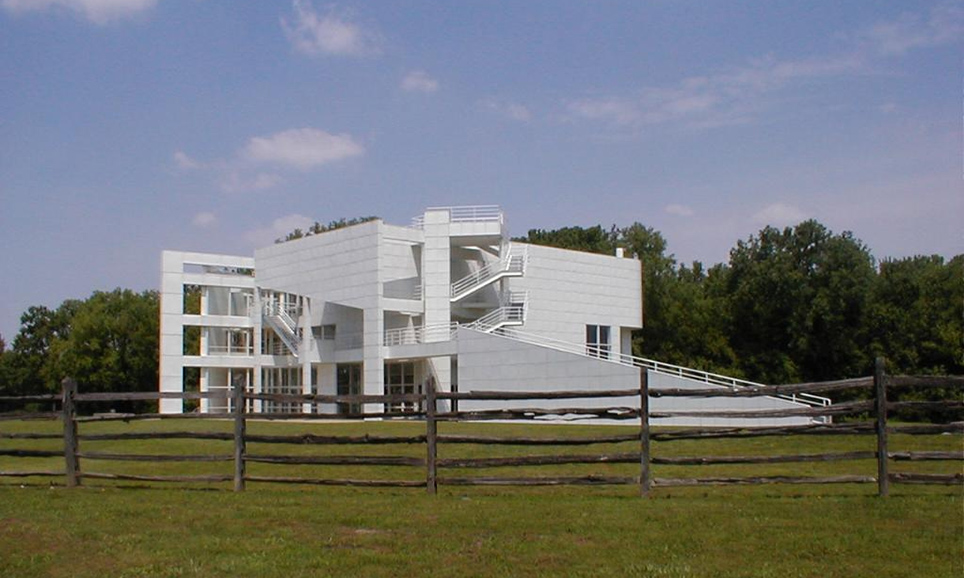Once conceived as a socialist utopia, today New Harmony is a curiously equal community inhabiting an equally curious architectural legacy
Looking out from the curved-glass ribbon window in Richard Meier’s 1979 Atheneum visitor centre onto its landscaped grounds, you wonder who commissioned this deconstructed cube in a rural Midwestern town 250 miles from Chicago. Inside this late Modernist belvedere, the exhibitions narrate the genesis and development of a town with a remarkable history.
Founded in 1814 by the Harmonist community led by Father Rapp, a Pietist prophet who left Germany with his followers to escape religious persecution, the town was subsequently purchased in 1824 by Robert Owen, father of British Socialism, and renamed New Harmony. Owen set out to substitute the religious legacy of the founders’ vision with a new moral order based on scientific and secular values. Whereas the Harmonists left a number of churches and timber houses, Owen, followed by Jane Blaffer Owen (his great-granddaughter- in-law) commissioned a legacy of compelling buildings architecturally reflecting New Harmony’s changing moral agenda. Jane Owen’s first project for the town, Philip Johnson’s Roofless Church, was inaugurated in 1960. The billowing exterior surface of the open-air, tent-like dome is clad with wood shingles echoing the organic forms and materiality of New Harmony.
Zion & Breen’s 1966 design for Paul Tillich Park was an evocative tribute to the renowned theologian who served as one of Jane Owen’s most important spiritual mentors. Robert Zion, the landscape architect known primarily for collaborating with Johnson on MoMA’s Abby Aldrich Rockefeller Sculpture Garden, introduced evocative, grassless, earth berms planted with Norwegian spruce and hemlock trees. Among these berms lie granite boulders inscribed by Anglo-German sculptor Ralph Beyer. By harnessing Modernist architecture, gardens and landscape, as well as directing preservation efforts, Jane Owen imagined a ‘new’ New Harmony as a site of spiritual pilgrimage to counter the anxieties of the modern age. She eliminated the dogmatism of the Harmonist (religious) and Owenite (secular) legacies, by creating a place defined by the coexistence of everyday spirituality with the economic demands of a living town.

Philip Johnson’s Roofless Church, Jane Owen’s first project for New Harmony
New Harmony is unlike other small ‘cultural towns,’ favoured by the New Urbanists, in that the majority of residents lead working lives in agriculture and industry related jobs that do not intersect with the aspirations of its high culture activities. Through the seasons, you are just as likely to see the carcass of deer and turkeys brought in pick-up trucks to the petrol station to be checked, as you are to see a choir of Benedictine monks visit the town to sing plainsong in Philip Johnson’s Roofless Church. An active group of artists, musicians and artisans annually come to New Harmony to follow their dreams for a few years or stay for a lifetime drawn by inexpensive real estate, a quiet lifestyle and proximity to nature. A growing retirement community also makes the most of the theatre, music performances, festivals and lectures staged by the many not-for-profit organisations and University of Southern Indiana, which has made New Harmony its unofficial arts and humanities campus.
The town lives and breathes the paradoxes created by the mix of high and low culture: on a Sunday afternoon you can hear pistol shots on the edge of town or arias from visiting opera singers filling the air. In New Harmony’s version of utopia, residents understand that there is room for many ways of life and different members of the community need each other, like it or not. Here, real-life politics knock at the door of the century’s old divisions, and, at best, fiddle toting country-boys and violin toting city-slickers understand that their music comes from the same instrument. It’s a question of being able to both listen to and hear each other’s tune that will cement aspirations for a real utopia.
 Architectural Review Online and print magazine about international design
Architectural Review Online and print magazine about international design


